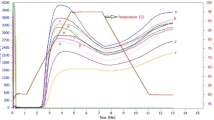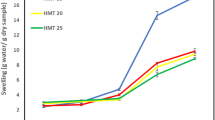Abstract
Starch modification studies have been carried out to overcome the shortcomings of native starches and to increase the usefulness of starch for industrial applications. The thermal, structural and pasting properties of starch from chestnut fruits (Castanea sativa, Mill), which were modified by mixtures of water–HCl, methanol–HCl and ethanol–HCl at different concentrations, were assessed. The thermogravimetry (TG) results showed that the chestnut starches had lower thermal stability when compared to starch from other botanic sources; however, after treatment, this stability increased. The differential scanning calorimetry results confirmed the gradual degradation of the amorphous areas of the starch granules by the acid–water mixture, which was enhanced by acid–ethanol treatment, leading to more crystalline residues that needed higher enthalpy to gelatinise. Using X-ray powder diffractometry, it was possible to observe a C-type starch and a reduction in relative crystallinity values when compared to native starch. In addition, the pasting viscosities decreased in all the modified starches, as was expected. However, obvious defects or signs of damage on the surface of the granules were not observed after treatment. This study is helpful to better understand the relationships between structure and functional properties in relation to the eventual industrial application of chestnut starches.





Similar content being viewed by others
References
Demiate IM, Oetterer M, Wosiacki G. Characterization of chestnut (Castanea sativa, Mill) starch for industrial utilization. Braz Arch Biol Technol. 2001;44:69–78.
Benjamin H. Under the spreading chestnut trees. In: Views of the world. University of Oxford; 2015. http://www.viewsoftheworld.net/?p=4681. Acessed 15 Apr 2016.
Carocho M, Antonio AL, Barreira JCM, Rafalski A, Bento A, Ferreira ICFR. Validation of gamma and electron beam irradiation as alternative conservation technology for European chestnuts. Food Bioprocess Technol. 2014;7:1917–27.
Blomhoff R, Carsen MH, Andersen LF, Jacobs DR. Health benefits of nuts: potential role of antioxidants. Br J Nutr. 2006;96:52–60.
Peroni FHG, Rocha TS, Franco CML. Some structural and physicochemical characteristics of tuber and root starches. Food Sci Technol Int. 2006;12:505–13.
van der Maarel MJEC, Leemhuis H. Starch modification with microbial alpha-glucanotransferase enzymes. Carbohydr Polym. 2013;93:116–21.
Correia P, Cruz-Lopes L, Beirao-Da-Costa L. Morphology and structure of chestnut starch isolated by alkali and enzymatic methods. Food Hydrocoll. 2012;28:313–7.
Qiao D, Zou W, Liu X, Yu L, Chen L, Liu H, Zhang N. Starch modification using a twin-roll mixer as a reactor. Starch/Stärke. 2012;64:821–5.
Zhu F. Impact of ultrasound on structure, physicochemical properties, modifications, and applications of starch. Trends Food Sci Technol. 2015;43:1–17.
Kaur B, Ariffin F, Bhat R, Karim AA. Progress in starch modification in the last decade. Food Hydrocoll. 2012;26:398–404.
Ferrini LM, Rocha TS, Demiate IM, Franco CM. Effect of acid–methanol treatment on the physicochemical and structural characteristics of cassava and maize starches. Starch/Stärke. 2008;60:417–25.
Utrilla-Coello RG, Hernández-Jaimes C, Carrillo-Navas H, González F, Rodríguez E, Bello-Perez LA, Alvarez-Ramirez J. Acid hydrolysis of native corn starch: morphology, crystallinity, rheological and thermal properties. Carbohydr Polym. 2014;2014(103):596–602.
Sodhi NS, Chang Y, Midha S, Kohyama K. Molecular structure and physicochemical properties of acid–methanol-treated chickpea starch. Int J Food Sci Nutr. 2013;16:125–38.
Lin JH, Pan CL, Hsu YH, Singh H, Chang YH. Influence of moisture content on the degradation of waxy and normal corn starches acid-treated in methanol. Food Hydrocoll. 2012;26:370–6.
Lin JH, Lee SY, Chang YH. Effect of acid–alcohol treatment on the molecular structure and physicochemical properties of maize and potato starches. Carbohyd Polym. 2003;53:475–82.
Lin JH, Chang YH. Molecular degradation rate of rice and corn starches during acid–methanol treatment and its relation to the molecular structure of starch. J Agric Food Chem. 2006;54:5880–6.
Lin JH, Wang SW, Chang YH. Impacts of acid–methanol treatment and annealing on the enzymatic resistance of corn starches. Food Hydrocoll. 2008;23:1465–72.
You S, Izydorczyk MS. Comparison of the physicochemical properties of barley starches after partial α-amylolysis and acid/alcohol hydrolysis. Carbohydr Polym. 2007;69:489–502.
Mukerjea R, Slocum G, Robyt JF. Determination of the maximum water solubility of eight native starches and solubility of their acidic–methanol and ethanol modified analogues. Carbohydr Res. 2007;342:103–10.
Pumacahua-Ramos A, Demiate IM, Schnitzler E, Bedin AC, Telis-Romero J, Lopes-Filho JF. Morphological, thermal and physicochemical characteristics of small granules starch from Mirabilis jalapa L. Thermochim Acta. 2015;2005(602):1–7.
Rafiq SI, Jan K, Singh S, Saxena DC. Physicochemical, pasting, rheological, thermal and morphological properties of horse chestnut starch. J Food Sci Technol. 2015;52:5651–60.
Malucelli LC, Lacerda LG, Carvalho-Filho MAS, Fernández DER, Demiate IM, Oliveira CS, Schnitzler E. Porous waxy maize starch: thermal, structural and viscographic properties of modified granules obtained by enzyme treatment. J Therm Anal Calorim. 2015;120:525–32.
Colman TAD, Demiate IM, Schintzler E. The effect of microwave radiation on some thermal, rheological and structural properties of cassava starch. J Therm Anal Calorim. 2014;115:2245–52.
Sun Q, Han Z, Wang L, Xiong L. Physicochemical differences between sorghum starch and sorghum flour modified by heat–moisture treatment. Food Chem. 2014;145:756–64.
Beninca C, Colman TAD, Lacerda LG, Carvalho Filho MAS, Bannach G, Schnitzler E. The thermal, rheological and structural properties of cassava starch granules modified with hydrochloric acid at different temperatures. Thermochim Acta. 2013;552:65–9.
Lacerda LG, Colman TAD, Bauab T, Carvalho Filho MAS, Demiate I, Vasconcelos EC, Schnitzler E. Thermal, structural and rheological properties of starch from avocado seeds (Persea americana, Miller) modified with standard sodium hypochlorite solutions. J Therm Anal Calorim. 2014;115:1893–9.
Lacerda LG, Carvalho Filho MAS, Demiate I, Bannach G, Ionashiro M, Schnitzler E. Thermal behaviour of corn starch granules under action of fungal α-amylase. J Therm Anal Calorim. 2008;93:445–9.
Stawski D. New determination method of amylose content in potato starch. Food Chem. 2008;2008(110):777–81.
Atichokudomchai N, Varavinit S, Chinachoti P. Gelatinization transitions of acid modified tapioca starches by differential scanning calorimetry. Starch/Starke. 2002;54:296–302.
Luo ZG, Fu X, Gao QY, Yu SJ. Effect of acid hydrolysis in the presence of anhydrous alcohols on the structure, thermal and pasting properties of normal, waxy and high-amylose maize starches. Int J Food Sci Technol. 2011;46:429–35.
Cavallini CM, Franco CML. Effect of acid–ethanol treatment followed by ball milling on structural and physicochemical characteristics of cassava starch. Starch/Stärke. 2010;62:236–45.
Scmiele M, Sehn GAR, Santos VS, Rocha TS, Almeida EL, Nabeshima EH, Chang YK, Steel CJ. Physicochemical, structural and rheological properties of chestnut (Castanea sativa) starch. Am J Food Sci Technol. 2015;3:1–7.
Zhou Y, Hoover R, Liu Q. Relationship between α-amylase degradation and the structure and physicochemical properties of legume starches. Carbohydr Polym. 2004;57:299–317.
Shi M, Lu W, Yu S, Ward R, Gao Q. Effect of acid–ethanol treatment on physicochemical properties and in vitro digestibility of maize starches varying in AM content. Starch/Stärke. 2014;66:429–35.
Gunaratne A, Hoover R. Effect of heat–moisture treatment on the structure and physicochemical properties of tuber and root starches. Carbohydr Polym. 2002;49:425–37.
Gul K, Riar CS, Bala A, Sibian MS. Effect of ionic gums and dry heating on physicochemical, morphological, thermal and pasting properties of water chestnut starch. LWT Food Sci Technol. 2014;59:348–55.
Chen X, He X, Fu X, Huang Q. In vitro digestion and physicochemical properties of wheat starch/flour modified by heat–moisture treatment. J Cereal Sci. 2015;63:109–15.
Cruz BR, Abraão AS, Lemos AM, Nunes FM. Chemical composition and functional properties of native chestnut starch (Castanea sativa, Mill). Carbohydr Polym. 2013;94:594–602.
Chung YL, Lai HM. Molecular and granular characteristics of corn starch modified by HCl-methanol at different temperatures. Carbohydr Polym. 2006;63:527–34.
Adebowale AA, Sanni LO, Awonorin SO. Effect of texture modifiers on the physicochemical and sensory properties of dried fufu. Food Sci Technol Int. 2005;11:373–82.
Acknowledgements
The authors thank the financial support provided by Coordination for the Improvement of Higher Education Personnel (CAPES) and to LabMu at UEPG for X-ray and SEM analysis.
Author information
Authors and Affiliations
Corresponding author
Rights and permissions
About this article
Cite this article
Kubiaki, F.T., Figueroa, A.M., de Oliveira, C.S. et al. Effect of acid–alcoholic treatment on the thermal, structural and pasting characteristics of European chestnut (Castanea sativa, Mill) starch. J Therm Anal Calorim 131, 587–594 (2018). https://doi.org/10.1007/s10973-016-5832-9
Received:
Accepted:
Published:
Issue Date:
DOI: https://doi.org/10.1007/s10973-016-5832-9




